Get A Flat Stomach

How To Get A Flat Stomach
You’ve probably heard the saying “Abs are made in the kitchen.” And it’s true.
While working out can help strengthen, tone and define your abs, if you want to really discover how to get a flat stomach then you have to start in the kitchen. Now with us all staying indoors more and working from home, it has never been a better time to start.

Lets be honest, no-one likes to diet. No one likes to restrict their treats, count calories or cook healthy meals that take forever. But eating clean and keeping your diet under control is the best way to really get results.
“Can’t I just run more and do more squats?” I hear you say. Sadly not.
Exercising for weight loss relies on that one simple rule: calories in vs calories out.
But there’s much more to it than that. Stress, genetics and hormones play a big part in how easily you gain weight and how difficult it is to lose fat. Burning calories through exercise is surprisingly hard, so it needs to start with clean eating - were not saying a diet.
The term diet is a loss in itself, it is short term. You need to look to change your lifestyle and not just go on a 'diet' for a short amount of time.
Did you know that one Starbucks Frappuccino with a slice of lemon cake just added 1000 calories to your day. Yes, 1000 calories can you believe it! You would have to jog non stop for 2 full hours just to get back to where you were before your coffee shop treat. Half an hour lifting weights in the gym burns an average of 100 calories. That is equivalent to one banana or one cereal bar or one slice of toast.
It’s going to be pretty tough to exercise away every excess calorie if you don’t watch what you eat. We are not saying is that it is not a waste of time working out, definitely not. Exercise is not only the single most important thing you can do for both your physical and mental health, but it also helps speed up your metabolism. Exercise promotes muscle growth, tones your muscles and burn off excess body fat. It just can’t compensate for a bad diet.
Are Abs Made In The Kitchen
A calorie deficit is the most important and is the correct answer you’re looking for. Without a controlled, healthy, nutritious diet you won’t see your abs no matter how many sit-ups you attempt! You could plank for two hours a day but if you’re eating into a big calorie surplus (consuming more calories than you’re burning off) then you’re shooting yourself in the foot!
If you aren’t losing weight or can’t see any physical changes in the mirror, then you’ll need to do one of two things. Either decrease your calorie intake or increase the amount of exercise you’re doing. Both will aid towards pushing your overall calorie intake down slightly.
So what should you eat if you want to get a flat stomach?
First, you need to understand that it’s not just fat loss that you want – it’s muscle growth too. You see, abs are muscles. That defined, toned stomach is that way because the muscles in your stomach are strong and toned. So you’ll need a diet that not only instigates fat loss but also gives your body the nutrients it needs (plenty of protein) to build those abdominal muscles.
Keto Is King
When it comes to fat loss AND muscle growth then Keto is king. The Keto Diet is a fat loss diet that is a low carb style of eating. It’s actually the only diet that’s been proven to help build muscle at the same time as burning fat – which is exactly what we want to do.
It’s naturally pretty clean – when you cut out carbs you automatically cut out sugars, refined flours and other “junk” foods. The typical Keto Diet is made up of low carb, high fat and moderate protein foods and meals. This would normally look like 5-10% Carbs, 20-30% Protein and 60-75% Fat.
If you’re new to Keto, learn more about why it's the number one diet for weight loss.
Research
In a 2011 study published in the International Journal of Obesity, 320 post-menopausal women ranging in weight from normal to obese were split into two groups. The first were asked to do 45 minutes worth of moderate-to-vigorous aerobic exercise, 5 times a week for a full year (they actually ended up averaging about 3.6 days per week). The second group did not exercise. And neither group was asked to improve nutrition or try portion control.
After one year, the exercise group lost an average of 5.3 pounds of body fat. That’s a lot of work to lose 5 pounds of fat.
HIIT, or high-intensity interval training, may be a more efficient approach to improving your body composition, especially in the abdominal region. One study compared two groups who exercised at different intensities: one that did three days a week of high-intensity exercise and another that did five days a week of low-intensity exercise. After 16 weeks, the high-intensity exercise group lost both more abdominal visceral and subcutaneous fat than the steady-state exercise one.
Science shows there’s no one-size-fits-all approach to dieting. A meta-analysis published in the Journal of the American Medical Association, reviewed 59 studies with various nutritional recommendations (low-fat, low-carb, etc).
Researchers found that weight loss differences between individual diets were small. Participants were able to change their body composition (lose weight) with both low carb and low-fat diets. However, getting the right amount of protein seems to be one of the most important things you can do to improve your body composition.
In another meta-analysis of 87 studies published in the American Journal of Clinical Nutrition, researchers found that low-carbohydrate, high-protein diets favorably affect body mass and composition. So it seems the consensus is that eating more protein can also help you preserve lean body mass when dieting.
Keto Diet
The ketogenic diet (or “Keto” ) consists of eating high fat, moderate protein, and very low carb foods. It’s similar to Paleo but carbs are restricted to 25-50 grams per day.
A 2013 meta-analysis that compared Keto to a low-fat nutritional plan suggests that keto is more effective for weight loss as well as improvement of cardiometabolic health.
Another study that compared the ketogenic diet to a low-fat diet found that Keto was effective in short-term body weight and fat loss. On top of that, it appears that Keto may support preferential fat loss in the trunk area, although this requires further validation.
Finally, a study in which men performed resistance training three times a week and compared body composition effects of keto vs. the traditional Western diet found that the ketogenic group experienced significant fat mass loss, as well as lean body mass gains, compared to the Western diet group.
Conclusion
Making adjustments to how you eat can lead to more fat loss in less time compared to exercise alone. So, the verdict? Abs are made in the kitchen and the gym. Like anything worth achieving in life, getting a six-pack takes both work and knowledge.
Doing 1000 crunches and 1 hour of cardio a day won’t help you see your abdominal muscles any faster if you don’t make the right changes to your diet.
“Spot reduction” is also another myth. You can target your abs and core with resistance training that help with the muscles in that area, but you also need to lose overall body fat to see the definition in those abdominal muscles– and that requires a combination of diet and exercise.






